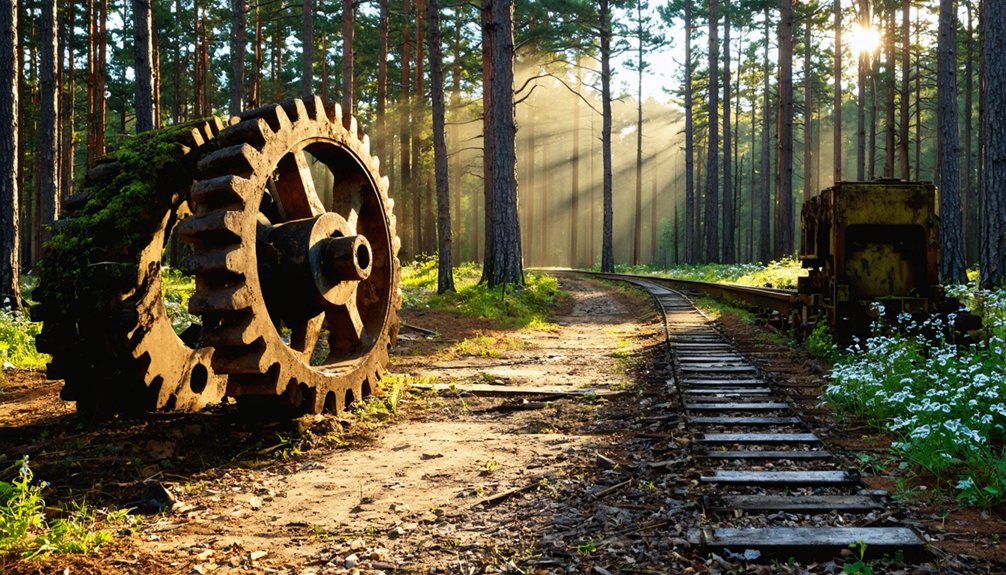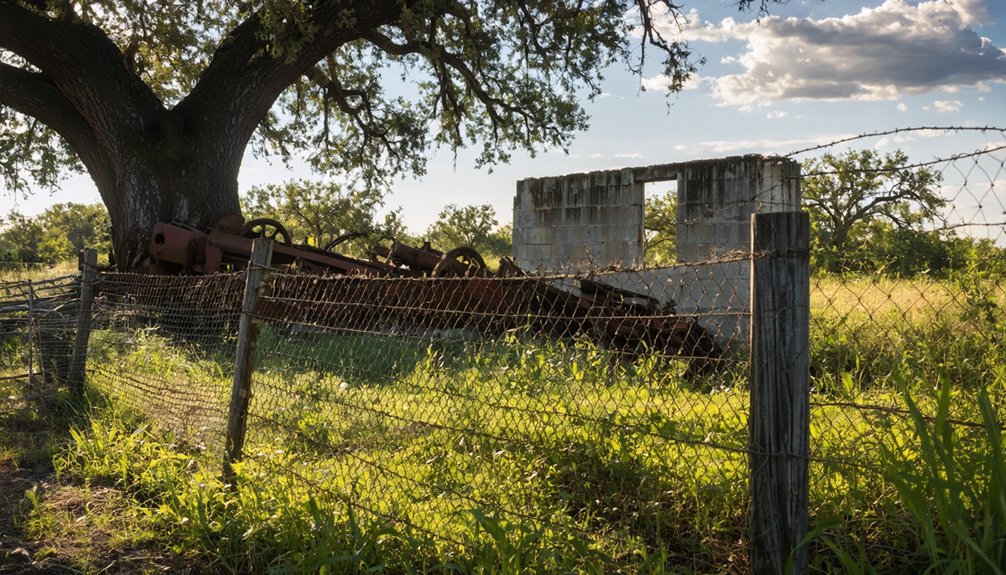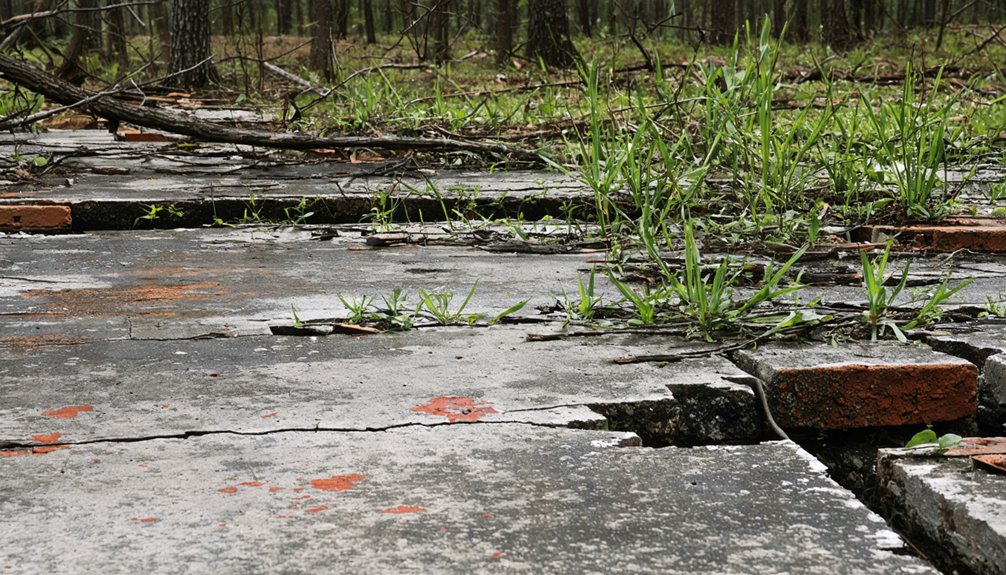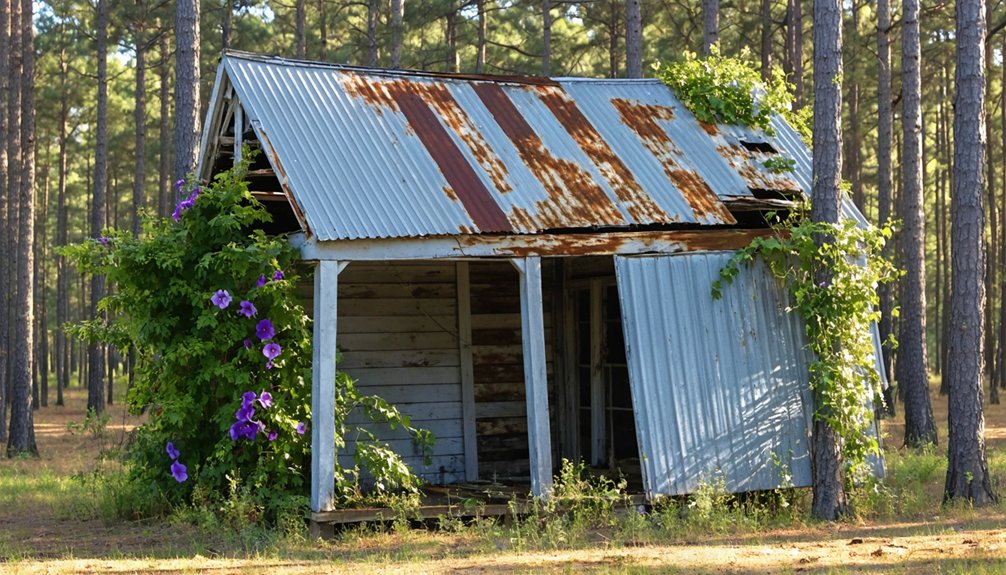You’ll find Fastrill nestled along the Neches River in Cherokee County, Texas, where Southern Pine Lumber Company built a logging camp in 1922. The arrival of the railroad transformed this site into a bustling community of 600 residents, complete with schools, churches, and stores. The town thrived until 1941, when improved highways replaced rail transport. Today, weathered foundations and scattered brick fragments hint at untold stories of this once-vibrant logging settlement.
Key Takeaways
- Fastrill was established in 1922 as a logging camp by Southern Pine Lumber Company, growing to 600 residents along the Neches River.
- The town featured homes, schools, churches, stores, and power plants, supported by railroad infrastructure for timber transportation.
- Economic decline began when highways replaced rail transport in 1941, leading to the town’s eventual abandonment.
- Few physical remnants remain today, with only weathered foundations, brick fragments, and deteriorating storefronts marking the former settlement.
- The ghost town site is located in Cherokee County, Texas, but access is limited due to private property restrictions.
The Rise of a Railroad Town
The whistle of progress echoed through western Cherokee County in 1922 when the Southern Pine Lumber Company established Fastrill as a strategic logging camp along the Neches River.
You’ll find this wasn’t just another timber outpost – it was a demonstration of logging technology and community resilience, positioned 50 miles from the bustling mill town of Diboll.
Similar to how local politicians strategically influenced rail routing for economic advantages, the railroad’s arrival transformed Fastrill into a thriving settlement of 600 residents.
You’d have seen portable homes designed for rail transport, schools, churches, stores, and power plants – all centered around the crucial railroad infrastructure.
The Angelina and Neches River Railroad connected this remote forest community to the wider world, while Southern Pine Lumber Company’s strategic rail planning guaranteed six-day workweeks of efficient timber harvesting and transport. Like many Texas rail lines of the era, this railroad helped overcome the challenges of poor road conditions that had previously limited regional commerce and development.
Economic Foundations and Early Industry
While Fastrill’s railroad infrastructure enabled its initial establishment, logging operations formed the bedrock of its economic foundation.
You’ll find that like many Texas towns of its era, Fastrill’s prosperity hinged on a single industry, making economic diversification challenges particularly acute. The community’s dependence on timber processing and railroad shipping created a vulnerable economic model, despite the initial boom period. Similar to how natural gas decline devastated Sutton County’s economy, Fastrill’s heavy reliance on a single resource proved unsustainable.
Community resilience strategies typically involved developing additional revenue streams beyond primary industries, but Fastrill struggled to expand beyond its logging identity. Like many areas along the Rio Grande corridor, the town’s isolated location and limited resources made economic diversification particularly challenging.
Unlike agricultural ghost towns that could sustain themselves through farming, or mining communities that might shift to tourism, Fastrill’s economic fate remained tightly bound to its timber operations.
When logging activities eventually declined, the town faced the same devastating pattern of population loss that plagued many single-industry Texas communities.
Daily Life in Peak Years
During Fastrill’s peak years, residents lived a life deeply intertwined with the timber industry’s demanding rhythms. You’d find thousands of residents, from railroad workers to merchants, all connected to the town’s bustling operations.
They’d live in modest worker cottages near industrial sites, making early morning shifts more manageable. Like many towns across Texas, the community’s survival depended on the unpredictability of resources. Miners faced tough conditions with a strict system of once-monthly paychecks.
While men worked long hours, women ran households and participated in community gatherings at the general store, church, and social halls. You could catch neighbors at evening dances or labor union meetings, fostering tight-knit bonds through shared experiences.
Life in Fastrill revolved around hard work and fellowship, with community bonds formed through shared dances, meetings, and daily routines.
The railroad served as your lifeline to the outside world, bringing mail, supplies, and occasional visitors. Despite basic amenities like limited indoor plumbing, you’d experience a strong sense of community as families supported each other through economic ups and downs.
Notable Buildings and Infrastructure
If you’ll head to Fastrill’s abandoned rail depot site, you’ll find weathered concrete foundations where the station once served as the town’s essential transportation link.
The town square’s architectural remnants include scattered brick fragments and deteriorating storefronts that hint at the commercial district’s former vibrancy. Like many similar communities, Fastrill faced steep decline when highway transportation reduced dependence on railways. Much like Thurber’s once-bustling mining operations, the town became a shell of its former self as economic shifts transformed the region.
Railroad ties and metal spikes still occasionally surface near the old right-of-way, marking where trains once transported lumber and supplies to and from this East Texas logging community.
Railroad Station Remnants
As a vital hub along the Texas South-Eastern Railroad, Fastrill’s railway infrastructure consisted primarily of temporary loading facilities and basic operational structures rather than permanent station buildings.
The former leasing arrangement with Texas and New Orleans Railroad helped establish key infrastructure before operations shifted in 1962. The railroad infrastructure supported logging operations through:
- Small depot structures serving as minimal transfer points between the Texas South-Eastern Railroad and Texas State Railroad lines
- Loading zones with timber racks and basic platforms where harvested logs were transferred from trucks to railcars
- Rail sidings that facilitated the movement of lumber from both sides of the Neches River toward mills in Diboll and Maydelle
- Simple spurs and loading docks designed for worker transport and timber handling, reflecting the camp’s temporary but essential role in East Texas logging
Today, you’ll find few traces of these once-bustling facilities, as most were dismantled before 1946. Operations continued under Southern Pine Lumber until their lease of the line ended in 1969.
Town Square Architecture
The remnants of Fastrill’s town square reveal a typical East Texas logging community’s architectural heritage, though little remains of the original structures today.
You’ll find the town hall architecture followed common patterns of the era, with local stone and brick construction reflecting the practical needs of frontier governance. While Fastrill didn’t have its own courthouse, the town square design mirrored those of other Texas communities where civic buildings anchored public life.
Walking the square, you can still spot scattered foundations and partial stone walls that once formed the community’s core.
These ruins tell the story of a once-bustling center where wooden commercial buildings with broad front porches faced the square, and communal water sources served the public’s daily needs.
Natural Resources and Development

If you’d visited Fastrill in its heyday, you’d have seen vast tracts of southern pine being harvested and loaded onto the Southern Pine Lumber Company‘s private rail network for transport to the mills in Diboll.
The logging operations thrived due to the area’s rich Piney Woods ecosystem evolving into Big Thicket territory, with the Neches River floodplain providing essential transportation access.
The intensive timber harvesting permanently altered the local environment, transforming dense forest into cleared land that would later be considered for alternative uses, including reservoir development.
Mining and Timber Operations
Mining operations transformed Fastrill’s landscape when William Whipple Johnson and Harvey Johnson established the town’s first coal mines in December 1886.
Coal extraction and timber harvesting defined the town’s development, with workers recruited from across Europe to power the growing industrial complex.
The mining and timber operations shaped Fastrill’s character in several key ways:
- You’d find immigrant workers from Poland, Italy, Britain, and Ireland working the coal seams.
- The company controlled access with barbed wire fences and guards to prevent union organizing.
- Many miners possessed multiple skills, combining coal work with trades like bricklaying.
- Timber operations supported the mines by providing construction materials and fuel for steam engines.
The combined industries sustained Fastrill’s economy until operations ceased in the 1930s, leaving behind a transformed landscape and abandoned infrastructure.
Railroad Resource Transport
Railroads played a pivotal role in Fastrill’s resource-driven economy, with Southern Pine Lumber Company’s private rail lines serving as the town’s economic lifeline from 1922 onwards.
You’ll find that railway economics fundamentally shaped the community’s development, as dedicated logging railroads connected the 600-person camp to the lumber mill in Diboll. These crucial transport arteries enabled efficient timber transportation from remote forested areas to processing centers.
When loggers exhausted timber in one area, the rail system’s flexibility allowed for strategic relocation of housing and operations, maintaining the camp’s productivity.
This railway-based timber industry thrived until 1941, when improved highways began replacing rail transport. The shift marked the end of Fastrill’s rail-dependent logging operations, ultimately contributing to the town’s abandonment.
Environmental Impact Assessment
Long after the railroads ceased operations, environmental studies revealed the significant ecological stakes of developing Fastrill’s landscape. The environmental assessment highlighted critical concerns about transforming this historically significant area into a reservoir.
You’ll find the ecological consequences would dramatically reshape the region’s natural character:
- Over 6,000 acres of streams and 651,000 linear feet of waterways would face disruption.
- Multiple wetland types – forested, herbaceous, and shrub – would be permanently submerged.
- Six distinct land cover types, including essential wildlife refuge zones, would be impacted.
- Critical habitat for native flora and fauna would be compromised, threatening local biodiversity.
While Dallas’s water needs drove development plans, the reservoir would’ve supplied only 3% of the city’s future demands, making the environmental trade-offs questionable.
The Beginning of the End

As Southern Pine Lumber Company exhausted the surrounding timber resources, Fastrill’s fate was sealed.
The town’s unsustainable logging practices had stripped the land bare, leaving nothing to support its single-industry economy. You’d have witnessed families packing up their belongings, heading for towns with better prospects and railroad connections.
The economic isolation hit hard and fast. Without the steady hum of logging operations, Fastrill’s heartbeat grew faint.
Buildings stood empty, their maintenance neglected as workers sought employment elsewhere. There’d be no revival, no second chance for this company town.
The few remaining structures deteriorated rapidly, and essential services vanished one by one. Like many Texas timber camps before it, Fastrill’s shift from bustling community to ghost town was swift and irreversible.
Stories From Former Residents
Through oral histories and personal accounts, Fastrill’s former residents paint a vibrant picture of life in this once-thriving Texas timber town. Their stories reveal how strong community bonds shaped daily existence, even as economic shifts threatened their way of life.
You’ll discover how the town’s spirit manifested through:
- Multi-denominational church gatherings and town meetings that brought residents together, fostering mutual support during tough times.
- Seasonal work routines centered around timber operations, with families adapting to changing industrial demands.
- Cultural diversity that emerged from Southern U.S. settlers mixing with immigrant workers, enriching local traditions.
- Local trading posts and community stores that served as social hubs, where families like the Dials maintained essential supply lines.
These personal narratives capture the essence of a resilient community that faced both prosperity and decline with remarkable unity.
What Remains Today

You’ll find few physical remnants of Fastrill today, with most structures having succumbed to natural decay and demolition over the decades since the town’s abandonment.
The site’s location in Cherokee County is primarily accessible through private property, making visits challenging without proper permissions from current landowners.
While no formal preservation efforts exist specifically for Fastrill, some artifacts and photographs from the former logging town are maintained by regional historical societies and museums.
Physical Ruins Today
The physical remnants of Fastrill stand as weathered sentinels in the Texas desert, with several stone and adobe buildings from the mining era still visible despite severe decay.
As you explore these haunting ruins, you’ll encounter stark evidence of structural decay and cultural significance through:
- Roofless adobe structures with crumbling walls, revealing the skeletal framework of what was once a thriving mining community.
- An old cemetery marked by wooden crosses and stone markers, offering panoramic views of the surrounding desert landscape.
- Former mining facilities with eroded equipment bases and processing building remnants.
- Repurposed structures that now serve as tourist establishments, maintaining their historic facades while housing modern amenities.
Desert vegetation weaves through the foundations, as nature slowly reclaims these historic spaces against the backdrop of distant mountain ranges.
Access and Location Details
Deep in Cherokee County, East Texas, Fastrill’s remnants lie approximately 50 miles from Diboll along the winding Neches River.
You’ll need to navigate a network of county roads and unpaved forest trails to reach this former logging camp, as no major highways pass directly through the site. Historical maps and local Cherokee County records can help pinpoint the location, but you’ll want an off-road capable vehicle for the journey.
While the old Southern Pine Lumber Company railroad lines are long gone, their paths sometimes align with modern access routes.
You won’t find official visitor facilities or signage at the site, so proper planning is essential for visitor safety. Weather conditions can affect road accessibility, particularly during wet seasons, so time your expedition accordingly.
Historical Preservation Efforts
Despite decades of abandonment, scattered remnants of Fastrill’s logging town heritage persist across the former Southern Pine Lumber Company site.
You’ll find preservation challenges have taken their toll, with no active funding opportunities supporting the site’s conservation. The town’s physical legacy continues to fade as nature reclaims the landscape.
What you can still discover today:
- Weathered foundation remnants and scattered structural debris from the original township
- An old cemetery with partially legible headstones and group memorials for unknown miners
- Basic cemetery fencing and metalwork that once marked burial grounds
- Archaeological traces of former mining operations and residential areas
Without formal historical designation or preservation programs, Fastrill’s remaining features face ongoing deterioration, much like other neglected Texas ghost towns that lack organized conservation efforts.
Historical Impact on Texas Development
As lumber demands soared in early 20th century Texas, Fastrill emerged as a vital force in East Texas’s industrial development.
You’ll find its origins deeply rooted in Southern Pine Lumber Company’s innovative logging techniques, which transformed Cherokee County’s timber industry. The town’s strategic location near private railroads and the Neches River revolutionized local lumber transport.
Beyond its economic significance, Fastrill’s community dynamics shaped regional development through its mobile housing system and extensive infrastructure.
You can trace the town’s influence through its peak population of 600 residents, who enjoyed modern amenities like schools, churches, and a commissary.
The settlement’s eventual closure in 1941 marked a significant shift in Texas transportation, as highways replaced railways, forever changing the state’s industrial landscape.
Preserving Fastrill’s Legacy
While the physical remnants of Fastrill have largely vanished, today’s preservation efforts center on the Texas Forest Service‘s active management of the site and the state’s official historical marker.
You’ll find that modern educational initiatives focus on maintaining Fastrill’s legacy through various means:
- The Texas Forest Service conducts ongoing research at the site, linking historical timber practices to current environmental studies.
- State Historical Marker No. 11798 educates visitors about the town’s significance in East Texas logging history.
- Historical societies maintain archives of oral traditions and documents from Fastrill’s company town era.
- The site serves as a living classroom for understanding the impact of early 20th-century logging communities.
Through these preservation efforts, you’re able to connect with an important chapter in Texas’s industrial heritage, even as community engagement continues to evolve.
Frequently Asked Questions
Are There Any Documented Paranormal Activities or Ghost Sightings in Fastrill?
You won’t find documented ghost stories or paranormal investigations in Fastrill – there’s no evidence of supernatural activity during its brief logging camp history or at today’s Forest Service Research Center.
What Native American Tribes Originally Inhabited the Fastrill Area?
You’ll find the Comanches, Kiowas, and Tonkawas were the primary tribes in Fastrill’s area, with each group’s cultural heritage leaving distinct marks. Apache bands also passed through during their regional migrations.
Did Any Famous Outlaws or Historical Figures Ever Visit Fastrill?
You won’t find documented outlaw legends or historical visits to this area in the records. While famous figures may have passed through, there’s no solid evidence confirming any notable appearances.
What Was the Highest Recorded Population of Fastrill During Its Peak?
You won’t believe this, but there’s no officially recorded peak population for Fastrill. Based on historical significance and population growth patterns of similar Texas ghost towns, it likely reached several hundred residents.
Were There Any Major Disasters or Epidemics That Affected Fastrill?
You won’t find documented evidence of major epidemics or disasters impacting Fastrill. Unlike nearby towns that faced meningitis outbreaks or devastating fires, there’s no record of disaster response or epidemic impact here.
References
- https://www.amysatticss.com/ghost-towns/
- https://929thelake.com/texas-ghost-towns/
- https://www.youtube.com/watch?v=phjUE19A8HM
- https://en.wikipedia.org/wiki/List_of_ghost_towns_in_Texas
- https://www.lonestartreasure.com/texas-ghost-towns-and-their-buried-riches/
- https://www.wilcotx.gov/1635/Historical-Abandoned-Towns
- https://atlas.thc.texas.gov/Details/5073011798
- https://www.desertedtexas.org
- https://kicks105.com/ghost-town-strange-name/
- https://www.tshaonline.org/handbook/entries/railroads



